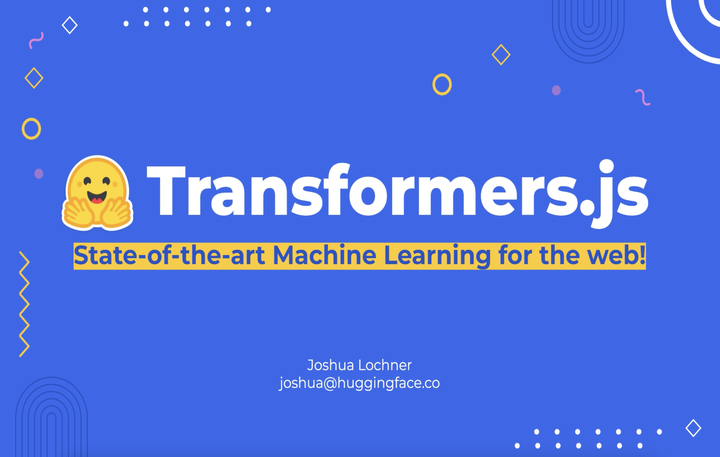
JioStar Dazzles the Digital Sky: A New Star is Born in the OTT Universe
November 12, 2024Transformers.js is one of the biggest strides in bringing state-of-the-art machine learning models directly to web browsers. Inspired by the Python transformers library from Hugging Face, the JavaScript library lets developers use NLP, computer vision, audio, and multimodal models directly without server-side processing. Let’s dive into the heart of Transformers.js, what it does, and its impact on changing client-side AI.
Transformers.js is a library of open-source code focused on running transformer models in environments that are based on JavaScript for a variety of applications, but especially for web browsers. The transformer model architecture that was first proposed in “Attention is All You Need” by Vaswani et al., has proved to be one of the most important structures in contemporary AI, especially in the areas of text understanding and generation; they work well with sequential data, utilizing self-attention among other mechanisms.
Browser Compatibility: Transformers.js allows models to be executed straight in the browser with WebAssembly (WASM). Models can then do text translations or classify images without needing to send them to another server, thus protecting the privacy of the user and less dependent on the server.
Versatility: The usage of models is really diverse. It includes text classification, named entity recognition, question answering, text generation, image classification, object detection, speech recognition, among many others.
Model Compatibility: The library supports a wide variety of transformer models, which comes from Hugging Face’s model hub. Models like BERT, GPT-2, T5, or even Vision Transformer (ViT) support all the different use cases that one may envision.
Ease of Use: As is the case with its Python counterpart, Transformers.js employ a pipeline API that makes the loading of models and their inference a very straightforward matter. Developers do not need an elaborate setup to integrate powerful AI models into a web application.
How Does Transformers.js Work?
Model Conversion: Models which were previously trained in some other frameworks like PyTorch or TensorFlow can be converted into the ONNX format, to be executed in the next steps by Transformers.js. This is when the conversion process will check if the model indeed executes on the browser environment.
WebAssembly: The library uses WebAssembly to run these models. WebAssembly is a low-level binary instruction format for a stack-based virtual machine. WASM enables web applications to perform at nearly native speed, making it quite all right to run very computationally intensive models like transformers.
JavaScript Interface: Transformers.js exposes JavaScript wrappers over the WASM modules so that JavaScript code can talk to the model with ease, starting from doing the preprocessed input, running the model, to finally post-process outputting the result.
Applications and Use Cases
Real-time Text Translation: Web applications can enable immediate translation services to the users, besides fetching better user experience. It does not share data with any external servers.
AI-Powered Chatbots: Transform.js can be used in building responsive chatbots like understanding outputs, generating human-like responses and can process inputs in a browser. This improves user engagement.
Image and Video Analysis: From simple image classification up to more challenging ones like depth estimation or segmentation, Transformers.js makes such applications available for use on the client side in augmented reality or in edit tools.
Voice and Speech Applications: Supporting audio-related tasks means direct integration of speech recognition or text-to-speech conversion directly into web-based applications so that audio feed can be provided, or voice commands can be processed without going to the cloud.
Challenges and Concerns
Performance: Though transformers are computationally efficient, their computational demands can be straining for less powerful devices or those with limited RAM.
Model Size: high performance models often come in sizes that make them heavy to download and store and might be unsuitable for all applications on the web.
Privacy and Security: Running models client-side has its benefits of privacy but puts other constraints. Any computation involving sensitive data must be handled extremely well to not leak such data through other avenues, like local storage or cross-site scripting vulnerabilities.
Future Prospects
Transformers.js is still evolving and improvements are being done in two main areas:
Improve performance on mobile browsers since there is relatively lower computational power.
Continued expansion of the Model Library: Support for many new models and tasks accelerates with AI developments.
Great performance can be expected when using GPUs directly in the browser for computations to be possible in future versions.
Transformers.js brings a whole new world of AI models applied into applications on the web with privacy focus, cost efficiency, and user experience. This makes it reduce the burden on a server significantly, but at the same time, gives it a new plane of interaction between users and AI altogether in the comfort of people’s devices, equipped with modern security. As the technology advances, so does the development of Transformers.js, which serves as a milestone for democratization in relation to AI access much of that would be reached with a browser. This piece should give you a full understanding of what transformers.js is, it’s working principle, and what it may really do to web applications as well as user interactions with AI technology.

